#historic estates
Explore tagged Tumblr posts
Photo
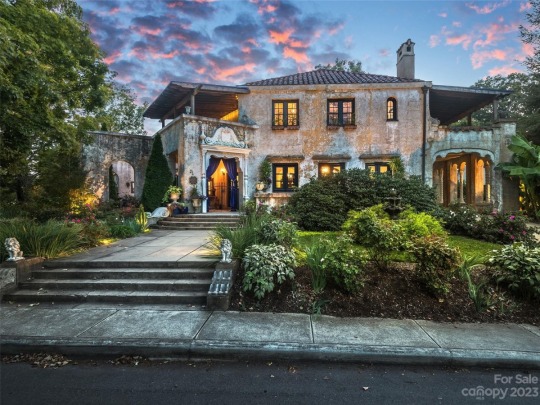

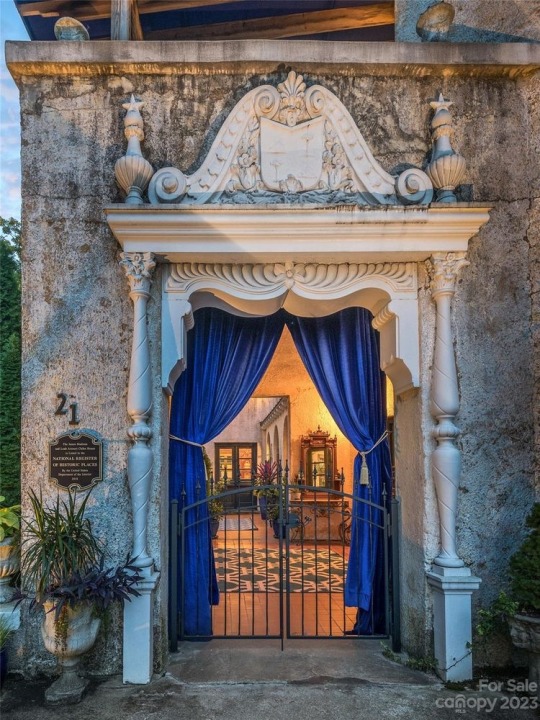
Magnificent 1922 Spanish Colonial Revival Chiles Estate looks ancient, doesn’t it? It’s in Asheville, North Carolina, has 5bd 4ba $2.495M.
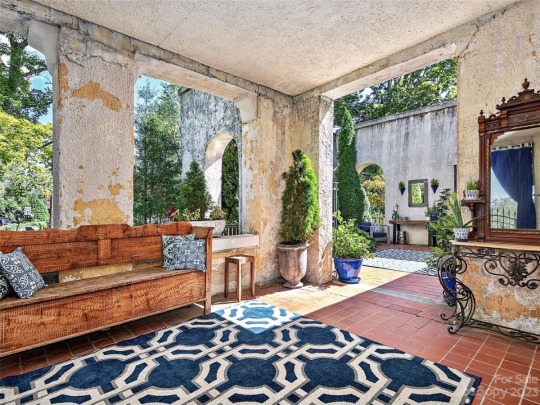
Isn’t this open entrance fabulous? Look at how the walls appear to be crumbling. This was the vision of prominent Asheville architect Ronald Greene and is known as Asheville’s *second* most famous home.

I’ve never seen columns set right into stairs. Isn’t that unusual? And, I also like the shelving in the stairs- good use of space.

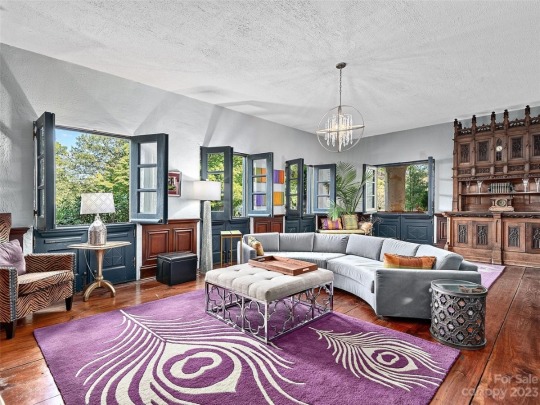
Very large sitting room- look how nice the windows open. Love that tile fireplace.

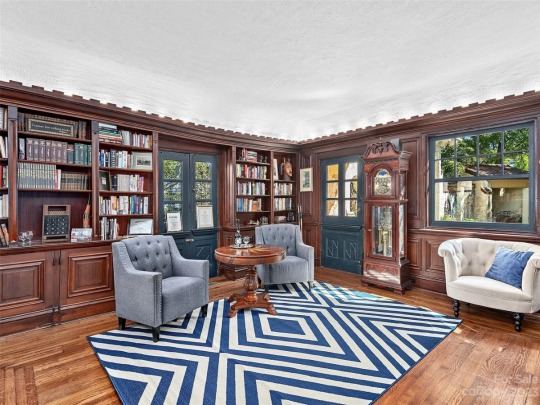
Beautiful library. Look at the up-lighting in the dental molding around the room and the way the ceiling curves.
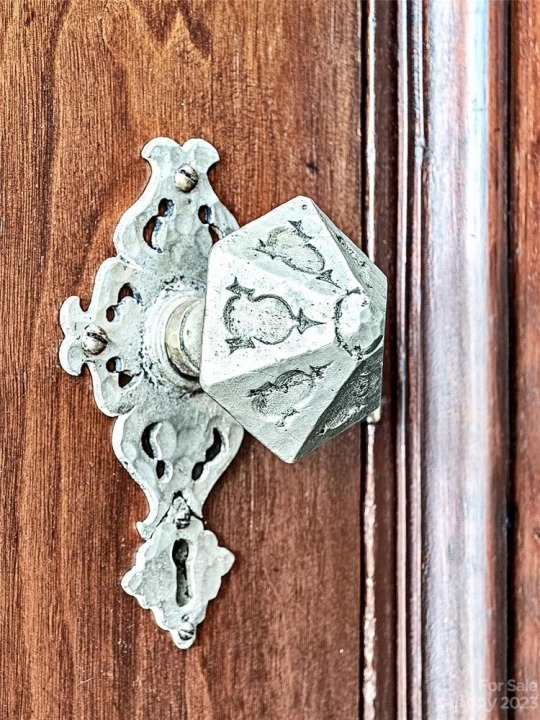
Details like this cool original door knob.

Isn’t the dining room beautiful? Love the blue ceiling and how it opens to the
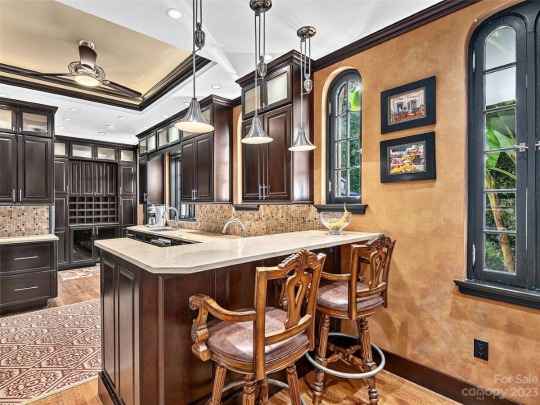

Love the kitchen remodel. I don’t know why, but I really like dark cabinets. This kitchen has an updated Spanish Colonial look. Very nice.
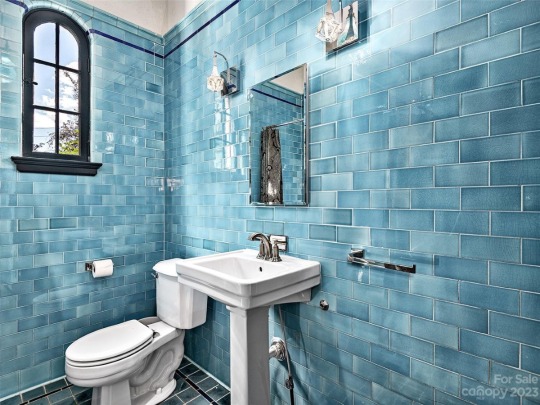
Striking blue subway tile bath.

Spacious main bd.
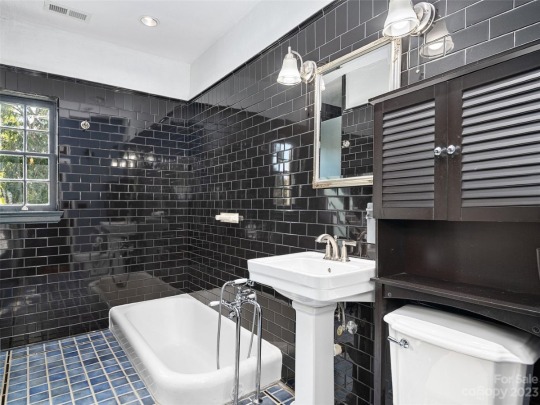
This is a stunning en-suite- black tile and white fixtures. Look at the vintage sunken tub.
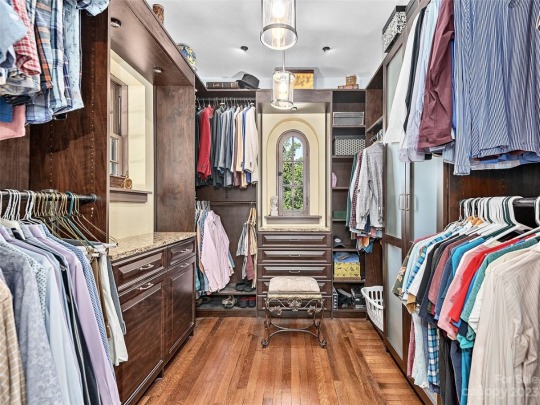
Beautiful walk-in closet/dressing room.
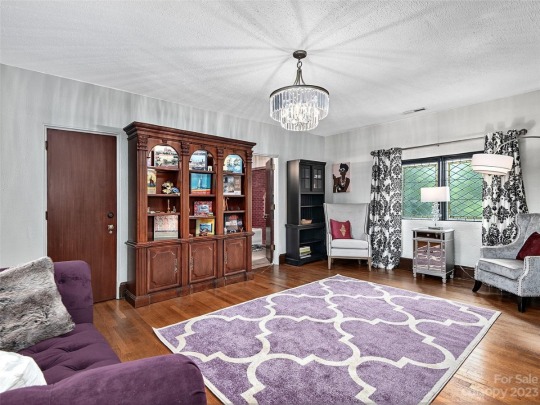
This is set up as a sitting room, but it’s really a bd b/c it has an en-suite.

Loving the rose tile and vintage tub.

And, this is one of the other bedrooms set up as a home office.


Lovely big terraces- one open an one covered.
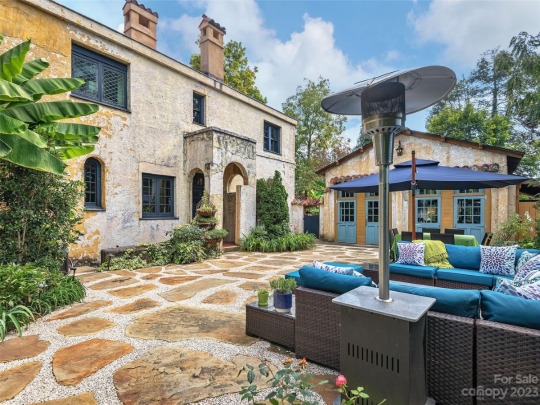
Patio behind the house.

Look at the dining room from the patio, and notice the covered outdoor walkway above.
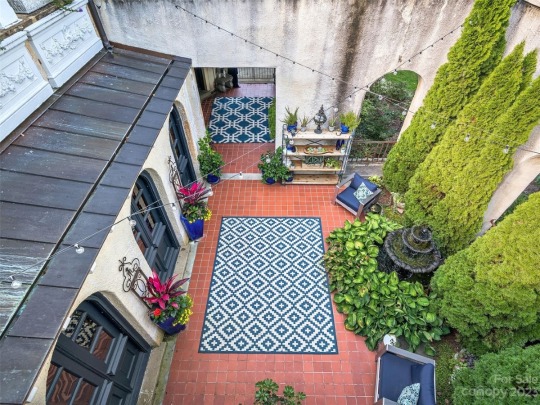
Looking down into the courtyard from above.
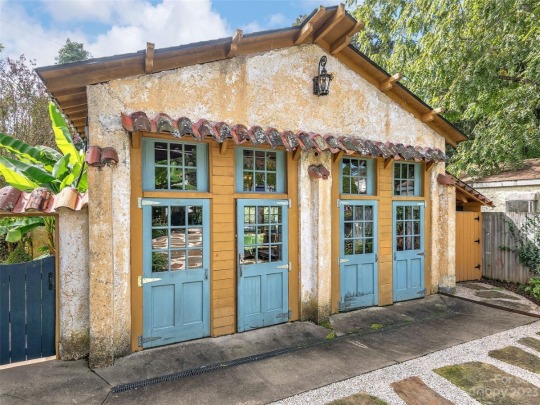
What a cute building.
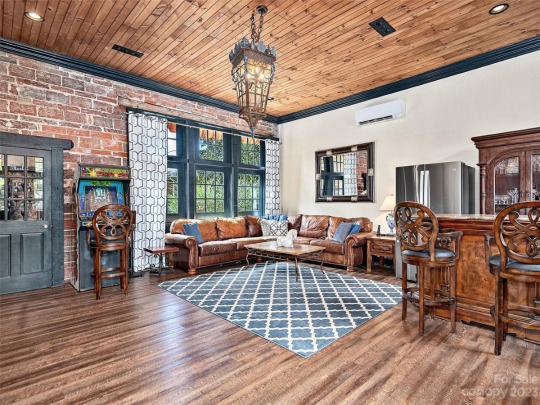
And, look what’s inside- a bar and entertaining space.

This is so cool.
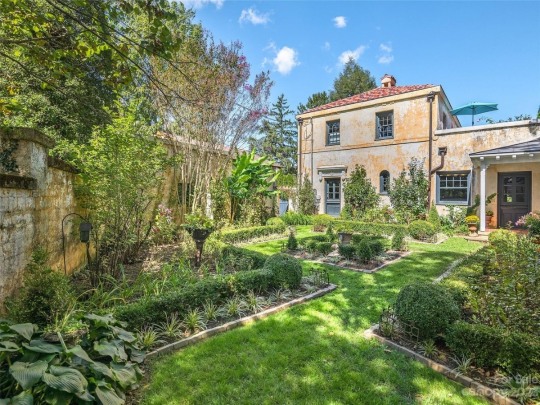

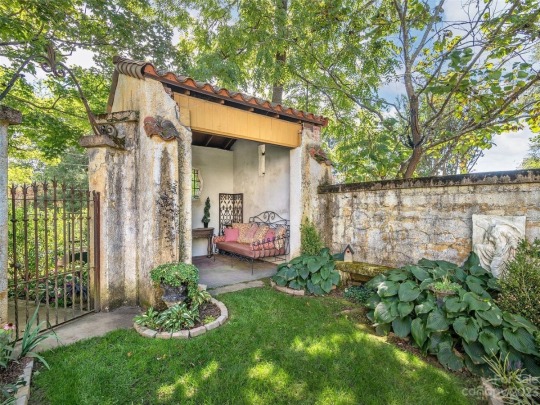
And, check out the gardens. What an amazing place to get away and be alone.
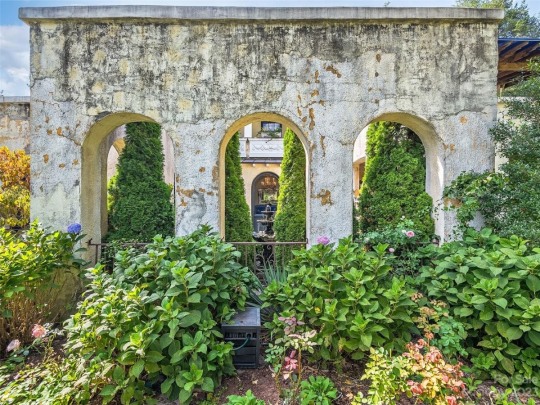
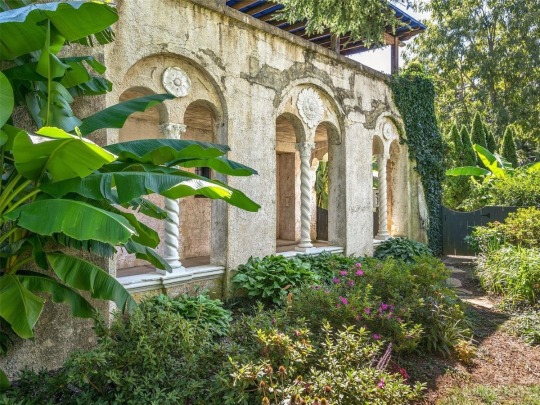
A stunning .37 acre property.
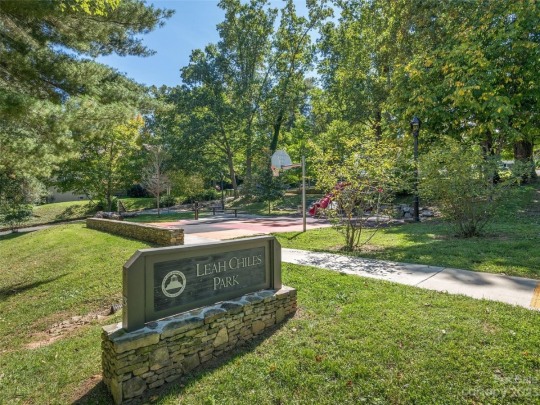
And look at this, it even has a park.
https://www.zillow.com/homedetails/21-Chiles-Ave-Asheville-NC-28803/5613975_zpid/
266 notes
·
View notes
Text
but genuinely I will never stop thinking about the museum scene. like it's upsetting in all the obvious setup-to-the-plot-twist ways, but more than that: the quietness of Steve’s presence vs. the booming grandiosity of the exhibit itself. The question of whether he had been previously (my guess would be yes) and if so, what a morbid, ghost-like ritual to perform just in order to cling to your memory, to remind yourself that it was real. What a blunt, reductive manifestation of not only everything you’ve lost, but the fact that your life and memory have become so entrenched a part of the public domain to the point that you’re viewed as about as much of a person as any one dusty item in that exhibit; the fact that you can’t access any of your world outside of yourself unless it’s through about a dozen second-hand, funhouse mirror narratives not only entirely co-opted by war but also tailored to fit a certain purpose. This one very public fucking horrific way to keep torturing yourself is one of your only remaining tethers to what you remember of your life. I mean. jesus christ steve
#i am so fucking sad.#and also: does he ever get any of his stuff back? has anyone kept any of it even? would the smithsonian even allow him access considering#it might be labeled to have historic value and since there’s zero precedent or protocol for someone coming back from the dead?#but even just. the paperwork and hassle of all of that.#I don’t think anyone likes having to deal with a departed’s estate#let alone when it’s /your own/ estate seventy years in the fucking future AND in the possession of a museum or otherwise lost to time#anyway.#max.txt#max’s miserable marvel rewatch
197 notes
·
View notes
Text

Claydon Pond Reflections - Alexandra Buckle , 2018.
British , b. 1984 -
Linocut on paper , 46 x 36 cm . Ed. 10
140 notes
·
View notes
Text










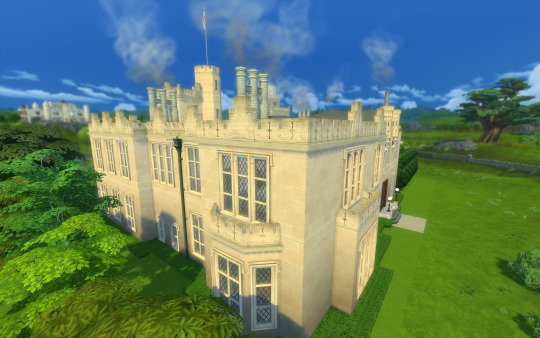


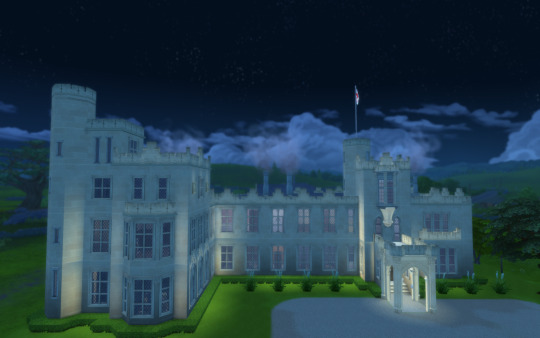
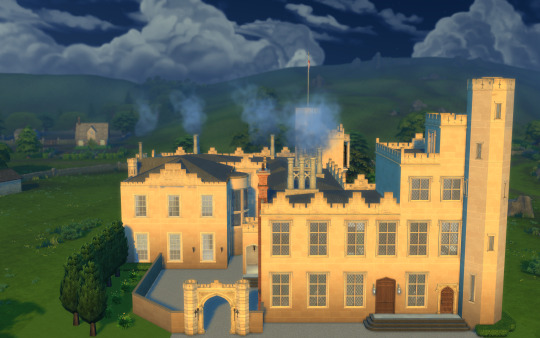
BIRKWOOD CASTLE
Hi guys!!
I'm sharing Birkwood Castle. This is the 23rd building for my English Collection!
I decorated some of the house ground floor, for reference.
History of the house:
Birkwood Castle, also known as Birkwood House, is a Gothic country house situated in Lesmahagow, South Lanarkshire, Scotland. Built in the 18th century, it was greatly expanded by the McKirdy family. In 1920 it was purchased by the local authority for use as a hospital.
Birkwood Castle was built in the late 18th century, and the original villa now forms the north wing of the house. It was greatly expanded in the Gothic style in 1858, and again in 1890 when the architect James Thomson of Glasgow designed the large west wing.
More history: https://lpha.org.uk/2024/07/29/the-mckirdys-of-birkwood/
INTERIORS:









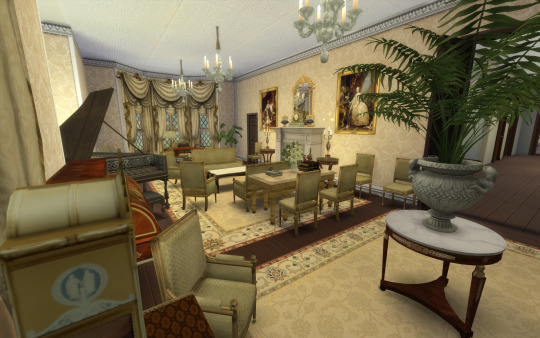

House file:
Location: Lesmahagow, South Lanarkshire, Scotland
Style: Gothic
Date: 18th century
This house fits a 50x40 lot.
I only decorated some of the important rooms. All the rest of the house is up to your taste to decor.
Hope you like it.
You will need the usual CC I use:
all Felixandre cc
all The Jim
SYB
Anachrosims
Regal Sims
King Falcon railing
The Golden Sanctuary
Cliffou
Dndr recolors
Harrie cc
Tuds
Lili's palace cc
FLOOR PLAN:




Please enjoy, comment if you like the house and share pictures of your game!
Follow me on IG: https://www.instagram.com/sims4palaces/
@sims4palaces
DOWNLOAD (early access 11/30/2024): https://www.patreon.com/posts/114013250
#sims 4 architecture#sims 4 build#sims4#sims4building#sims 4 screenshots#sims 4 historical#sims4play#sims4palace#sims 4 royalty#ts4#ts4 download#ts4 simblr#ts4 gameplay#ts4 legacy#ts4 screenshots#the sims 4#sims 4#sims community#the sims#sims 4 gameplay#the sims community#sims 4 builder#ts4 builder#gothic architecture#english estate#scotish architecture#scotish castle#ts4 herritage#sims4herritage
40 notes
·
View notes
Text








Des Moines, Iowa c.1899

#Victorian cottage#real estate#witchy#cottagecore#cottage aesthetic#cozycore#cozy aesthetic#purple#tiny houses#cozy cottage#des moines#iowa#$300k#victorian architecture#historic architecture#1899
37 notes
·
View notes
Text

the prompt was "den finally gets little a money and nor pickpockets him Immediately"
#hetalia#aph#historical hetalia#aph norway#aph denmark#dennor#hws denmark#demark aph#norway aph#hws norway#Denmark tries to sell Iceland to Prussia ONE TIME and Norway (not amused) is like 'it's free real estate' and just pickpockets him#my best friend @blabaerlakris came up with this for the record she deserves all the credit I just did the doodlin' lmao#also this is strictly for the lulz and not a reflection on Norway in any way I lit rally live in Norway 😭😭
280 notes
·
View notes
Text
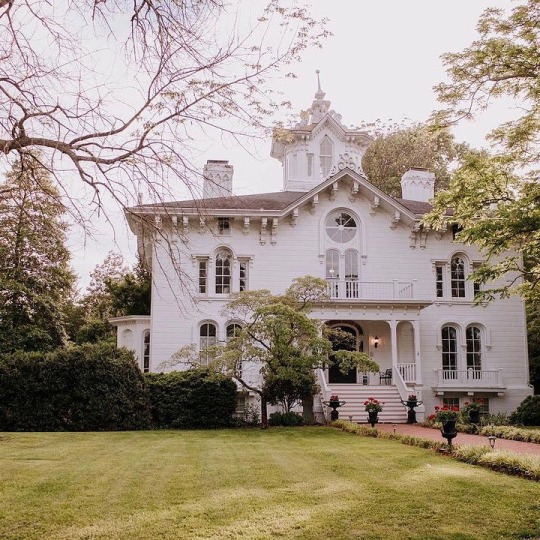
Mayhurst Estate༻❁༺
𝗁𝗍𝗍𝗉s://instagram.com/mayhurstestate
221 notes
·
View notes
Text
Incorruptible chap 2 pt 5
I'd like to think Robespierre was intensely excited and inspired during those early days in the Breton Club (I remember reading a letter that suggested as such)
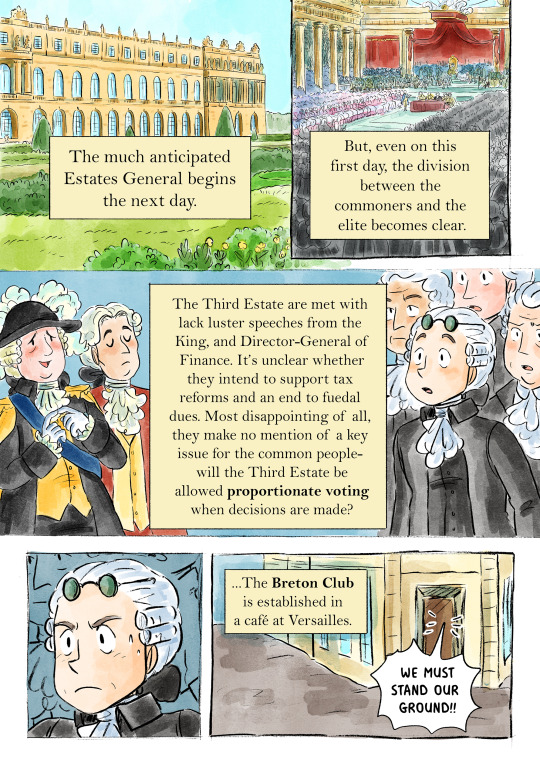
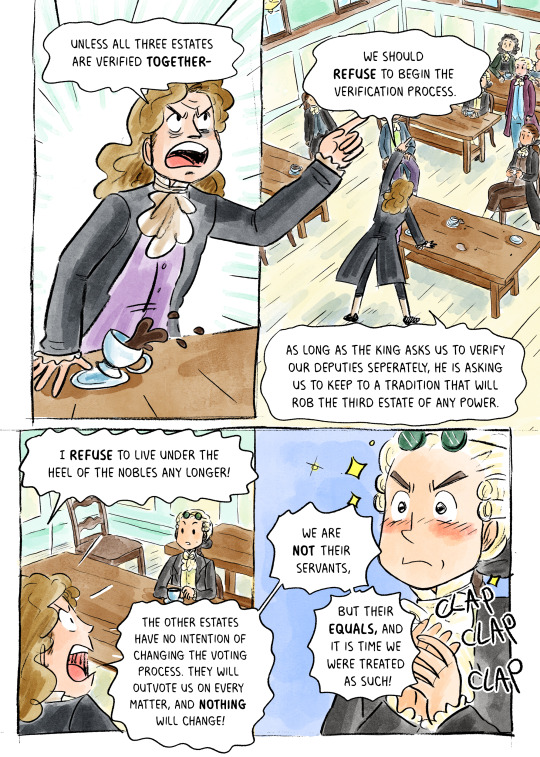
#incorruptiblecomic#I feel bad for showing Necker in a bad light since he really helped in the build up to Frev with his bold moves/popularity#but also it sounds like he really didnt read the room with his opening speech at the Estates General lol#Also me chanelling personal anger at current political situations into an angry Breton lol#french revolution#robespierre art#robespierre#frev#webcomic#comic#webtoon#historical fiction#maximilien robespierre#frev art#frev comic
136 notes
·
View notes
Text
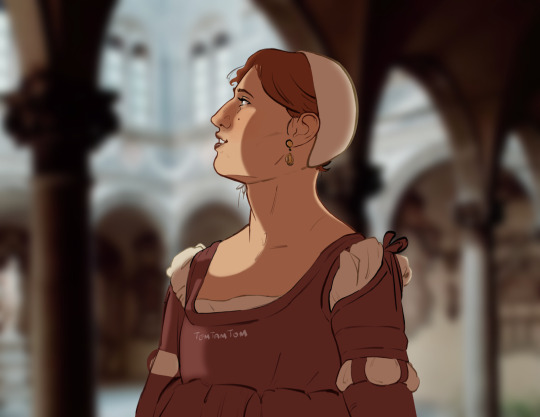
POV You’re the Holy Roman Empire and you see this pretty boy in the courtyard. WWYD?
Something nice and simple while I tackle uni work. Please don’t tag as Nyo Italy!
Flat version under the cut
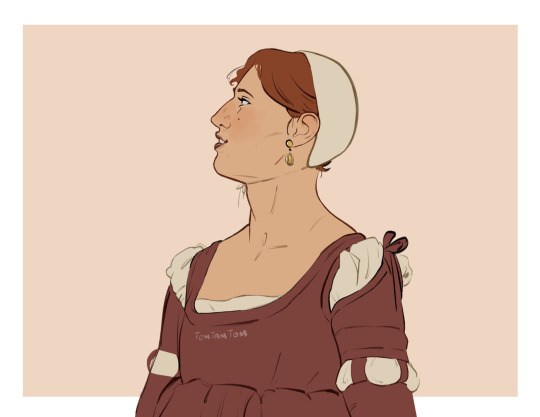
#aph italy#hws italy#aph veneziano#hws veneziano#historical hetalia#temmie tidbits#clothing might not be all that accurate but shhhhh it’s all about having fun#I’ve been drawing him a lot lately#my fave pretty boy#Karl looking at his neck and collarbones very very respectfully#it’s free real estate#I forgot to give him a necklace FACK#okay back to the animation grind
108 notes
·
View notes
Note
can we please have more haunted asylum house stories please
The funniest thing about the asylum is that it's not even the spookiest place I've stayed at tho it does get those extra points bc I had to live there for a year also we didn't know it used to be an asylum when we moved in we had to find out via history book about historical buildings in our county and the picture they used was the front of the house with two 1800s kids standing in front which I'm pretty sure just is the start of a horror movie but yeah the asylum was your basic creepy place at one point I heard horses in the stables despite us not having horses when we lived at that house at one point I was in the house alone and the tap started running and the dog we had at the time refused to go upstairs you know classic stuff
#ask#anon#but yeah when i was younger a friend of my sister used to hold giant Halloween parties#and i spent the summar at my grans house in cornwall one year#both houses were estates that were turned into apartments so spooky as hell#which im not sure how common that is in the rest of the world#but its fairly common here#instead of knocking down old buildings#theyll literally lock a door and go#yep thats an apartment#obviously bc they dont want to know down a historical building#but no one can really afford to live in a place like that#the one i used to spend halloween at#was also like a proper historical site#so all the tennets had to just live with the old furniture#i Just remember youd get so lost as all the tennets got involved in the Halloween party
42 notes
·
View notes
Text

Steve Silver stands inside his 5,000-square-foot loft in the Williamsburg neighborhood of Brooklyn, New York. Silver, a painter, moved into the loft in 1979.
A Look Inside New York’s Historic Artist Lofts
The Last of Their Kind.
They used to be printing shops, garment factories and flophouses. Now they’re some of the coolest artist spaces you’ll ever see.
These unique, expansive lofts, rarely seen by the public, are all over New York City.
For decades, they’ve been occupied by painters, sculptors and other artists who moved in when manufacturers started leaving the city in the second half of the 20th century.
“When people think of New York City as a cultural epicenter, these are the artists that they’re envisioning,” said Joshua Charow, a photographer and filmmaker who has spent the past few years documenting the artists and their studios for his book “Loft Law: The Last of New York City’s Original Artist Lofts.”

Artist Claire Ferguson moved into her loft in the city’s Tribeca neighborhood in 1981. At the time, the building in Lower Manhattan had a mix of artists and industrial tenants. “The floor below me was a paintbrush factory,” she told photographer and filmmaker Joshua Charow. “The floor above me put lines on paper before they had offset printing, and they had these huge machines. They had a guillotine that cut through the reams of paper every morning. At 6 a.m., they would turn it on, and it was this noise, aargh!”

JG Thirlwell’s loft in Brooklyn’s Dumbo neighborhood doubles as his home recording studio. “Loft living is not for everyone,” he told Charow. “You’re responsible for everything in here, and not everyone wants a life like that.”

A cat rests inside the Tribeca loft of Ken and Flo Jacobs, experimental filmmakers who moved into the space in 1965. At the time, the monthly rent for the 2,000-square-foot loft was just $70.
For the first half of the 20th century, New York City was a major manufacturing center. Factories were all over, producing everything from ice cream to torpedoes.
But when companies started finding it profitable to move their operations to other parts of the country and the world, many buildings were abandoned. By the 1960s and ‘70s, industrial neighborhoods, including those we now know as SoHo and Tribeca in Lower Manhattan, were largely deserted.
Landlords were desperate to find tenants. A big problem, however, was that the buildings were not zoned for residential use. Many of them didn’t have kitchens or showers, or even electricity or heat.
“The only people that would rent the space were artists,” Charow said. “And that’s because (the buildings) had tall ceilings, so they could make big work. They had big windows to let in lots of light. The spaces were completely raw, in many circumstances.”

Anne Mason sits in front of one of her late husband’s paintings in the loft they lived in together in the Little Italy neighborhood of Lower Manhattan. Frank Mason died in 2009, but his wife preserved his studio and his paintings.

Plants thrive in the natural light of the Midtown loft Bob Petrucci and Ray Bailey call home. It’s on the 16th floor of a building previously used as a necktie factory.
Artists would move into the empty factories and warehouses and make them more livable spaces. It was technically illegal, of course, but everyone was benefiting and the once-abandoned neighborhoods started to thrive again.
By the end of the ’70s, however, loft living had become quite fashionable and some landlords were looking to cash in, pushing out the artists for a wealthier clientele.
The artists pushed back, and in 1982 state lawmakers enacted Article 7-C of the New York Multiple Dwelling Law, which is commonly known as the 1982 Loft Law. This legislation gave protection and rent stabilization to people who had been living in these spaces. It also required landlords to bring the units up to residential code.
When the law was enacted, Charow says in his book, there were tens of thousands of artists living in lofts across the city. Now just a few hundred remain.

Noah Jemison moved to his Williamsburg loft in 1980. He remembers his neighborhood not having as much traffic as it does now. “You could walk down the streets and see nobody,” he told Charow. “It was a place where you could hear yourself think. It was perfect for artists.”

A scan of a 1913 blueprint shows one of the Manhattan buildings Charow photographed. New York City was a major manufacturing center for the first half of the 20th century.

Painter Betsy Kaufman walks inside her Tribeca loft. She uses the front half as her studio. It still has its original wooden floors.

Legislation enacted in 1982 allowed loft residents in New York to establish legal residence and have their living spaces brought up to code. It also stabilized their rent and protected them from eviction.
Charow wanted to document these artists — and their extraordinary lofts — before their numbers dwindled even more. He found a map of the remaining protected buildings and went door to door to see whether their tenants would be willing to share their story with him.
He was often rejected at first. But over time, more doors started to open up as people he met would introduce him to others.
Over the past three years, Charow has photographed 75 artists — 30 of whom are in his book.
“My life has been greatly enriched by meeting some of these artists and learning about their lives and their stories,” Charow said. “It’s had a big impact on just my life, and I can’t imagine how much of an impact this group of people has had on the city as a whole.”

Art created by Carolyn Oberst and Jeff Way adorn the walls of the loft they share in Tribeca. They live on the top two floors of a building they started renting in 1975. “I won’t tell you what it cost, but it was very cheap. We’ll just leave it at that,” Way told Charow. “But that was an incentive to fix it up. It was sweat equity, they called it.”
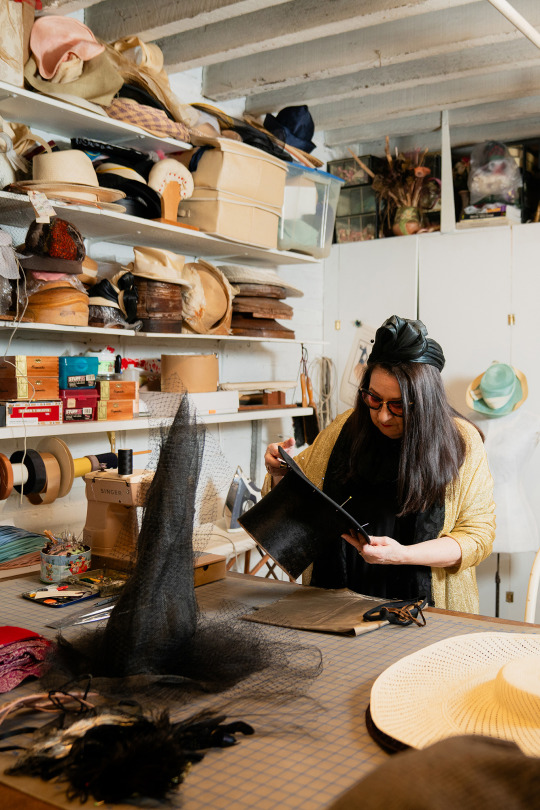
Ellen Christine makes new hats and restores old ones. She’s one of the last milliners in New York City. “In the 1930s, you could walk down any street, and there would be at least 30 milliners,” she said. “It was just (that) everybody wore hats, you see… So they needed new ones all the time.”

Curtis Mitchell remembers when he first walked into his loft in the Dumbo neighborhood of Brooklyn. The building used to be an ice cream factory. “It looked just like a dream,” he said. “To me, it still is a dream. It’s a fantastic place. Cold as hell in the winter and hot as hell in the summer, but I don’t care.”
One of Charow’s favorite spaces was the Bowery loft of Carmen Cicero, who is now 97 years old but moves with the energy of someone much younger, Charow said. Cicero lives in the loft with his wife, the art historian Mary Abell. Filling the space are hundreds of Cicero’s paintings, some bigger than he is.
“When you dream of what a painter in their loft in New York would be like, it’s Carmen,” Charow said. “And he’s filled with incredible stories. He has such phenomenal stories of his time as an artist here.”
Cicero’s work can be found in the permanent collections of the Whitney Museum of American Art, the Museum of Modern Art and the Smithsonian American Art Museum.
He told Charow the story of how he got his big break: “I had a lot of friends who thought I was a really remarkable painter. One day, they said, ‘Carmen, you’re going to a gallery.’ And they had two guys grab my feet, and two guys grab my arms — they threw me in the car and said, ‘We’re going.’ We went to four or five galleries, and almost every one of them wanted my work — I was lucky.”

Carmen Cicero lives in the Bowery, which has one of the highest concentration of Loft Law-protected buildings in the city. The painter moved to New York in 1971, after his home studio in New Jersey went up in flames
Charow says it has been a thrill to meet these artists and listen to their stories.
“The spaces are beautiful and interesting and historic in their own ways. But without the artists, these spaces lose the significance and the interest to me,” he said. “The artists are the ones who are giving the spaces meaning. Their decades of life and working there is what makes these spaces sort of a sacred thing.”
Through June 29, Charow’s photos are being exhibited at Westwood Gallery NYC, alongside the art of many of the people he photographed.
“I’m really excited that people get to see the paintings and sculptures and and see where they’re made,” he said.
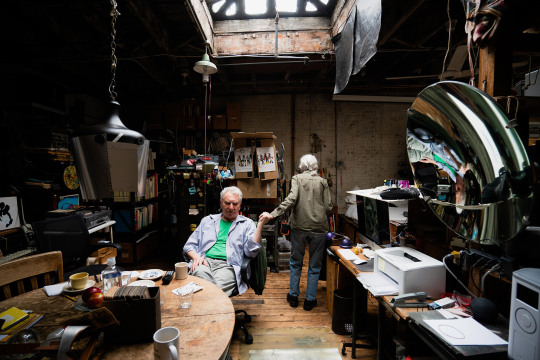
Filmmakers Ken and Flo Jacobs have lived in their top-floor Tribeca loft for more than 50 years. “Once, we staged a live shadow play with a stretched curtain in the loft. Our audience consisted of just two people: Yoko Ono and John Lennon,” Ken told Charow.

Sculptor Marsha Pels lives in what used to be a glass factory in Brooklyn’s Greenpoint neighborhood.
Even though the book is already published, Charow’s project will continue. After he began sharing his photos and videos, more artists started reaching out to him so that they could tell their story.
He now has a list of artists to photograph over the next few months.
“This isn’t just a thing of New York’s past. This is the present,” Charow said. “You can walk down the street and look at a window and you might see (an artist), and they’re still working and they’re still making their paintings and sculptures.
“I think it’s a beautiful part of our city, that this exists. It took a lot of resilience and ingenuity to stay in these spaces.”

Kimiko Fujimura, a painter, moved from Tokyo to New York City more than 50 years ago. She has lived in this Chinatown loft since 1979. It was the top floor of a former bow-and-ribbon factory.

The Lower Manhattan skyline is seen from a loft in Brooklyn.
Joshua Charow’s book, “Loft Law: The Last of New York City’s Original Artist Lofts,” is published by Damiani Books. The exhibition at Westwood Gallery NYCis taking place through July 13.
Photographs by Joshua Charow. Story by Kyle Almond. Published June 16, 2024
#Joshua Charow#A Look Inside New York’s Historic Artist Lofts#Joshua Charow “Loft Law: The Last of New York City’s Original Artist Lofts”#loft#real estate#art#artist#art work#art world#art news#art studio#long post#long reads
13 notes
·
View notes
Text

The historic 1926 RDW Clapp House in Wichita, KS is going up for auction on Aug. 16, but if someone buys it before then, the auction is off. It has 5bds, 7ba, and looks like a castle inside. Oh, and it has an $8mo. HOA.

Check it out, you enter thru a big arched door and iron gate. The entrance hall is stone. Very cool.

There's a fountain with a mural and interesting stairs.

The great room is incredible. Look at the wood, the built-ins, the high ceiling, chandeliers, and the balcony. This is crazy.

Beautiful fireplace. By the looks of the TV, it appears that the family really sits in here and watches TV. I would use it, too.

Look at the size of that window.

The formal dining room has a sculpted ceiling and floor-to-ceiling wood paneling.

The kitchen totally looks like a castle kitchen. Look at the wood.


Look at the exhaust hood over the stove.

This looks like a comfy little room.

An iron gate opens to a glass-walled brick hallway with a pitched wood ceiling.

The hall leads to this beautiful little room with a bar.

The elevator.

If this is the primary bedroom, I would've expected it to be more grand.

This vintage bath is nice. Cute tub and pretty marble walls.

This looks like a waiting room. There are 2 offices, so maybe it's one of them.

They made a home gym in here.

Outside, there's a pool.


Outdoor sitting areas and a fountain.

Beautiful grounds.


The lot is .84 acre. I'm surprised that it's not even an acre.
https://www.zillow.com/homedetails/320-N-Belmont-Ave-Wichita-KS-67208/77344776_zpid/?
145 notes
·
View notes
Note
Hi! First of all, I want to say that I really love your blog and all the content you have there. But for the actual question, so, I'm a new frev enjoyer, and I've been trying to look everywhere on the internet for the answer to a simple question that i seemingly can't find. What languages could Maximilien De Robespierre speak (beside french)? I swear, I've searched in every corner of the web and EVEN ASKED REDDIT AND QUORA??? I assume he understood Latin, since he studied law, but what about other popular languages, like Italian or Spanish? I don't know. I hope this question doesn't bother you, if you don't want to answer that's fine! Also I apologise for any grammatical mistakes, english is not my first language. Have a nice day!!! ♡
Hi, thank you for the lovely comment, it's definitely no bother at all!
You're absolutely right about Latin - anyone who received even a basic education in the 1700s would have at least a basic grasp of the language. Couldn't really do much without it! With someone like Robespierre, one can assume he would be pretty much fluent in Latin, or at least in reading Latin texts.
The only evidence for any other language he would have some knowledge of that I was able to find was not Italian or Spanish but Greek! Again, for the reason that it was very much a part of the classical education of that era.
(From an article about classical education in the 18th century:

This table also shows that, apart from seeming to be very well-versed in Latin, Robespierre would have at least some knowledge of Greek - enough to be able to win a prize for it, anyway:

I have to say I'm not quite sure about any modern languages! I would be leaning towards no. For instance I'd say that unlike some of the other revolutionaries like Jean-Paul Marat (or Voltaire and Émilie, who apparently learnt English in a matter of months), he wouldn't be able to speak English. I'm not hundred percent sure about Spanish or Italian though, as they are closer to French and therefore arguably easier to learn for a native French speaker.
If anyone knows more (@anotherhumaninthisworld ; @saintjustitude ?) I'd love to know as well!
Oh and least but not least welcome to the frev community and stay curious! ✨
RESOURCES:
Leuwers , Hervé. “Maximilien de Robespierre, student at Louis-le-Grand (1769-1781). The contributions of the accounting of the “college of Arras””, Historical Annals of the French Revolution , vol. 371, no. 1, 2013, pp. 175-185.
Classical Education in the Eighteenth Century, British Literature Wiki, https://sites.udel.edu/britlitwiki/classical-education-in-the-eighteenth-century/
#also there's a discussion about the 'de' part of Maximilien's name but I'm pretty sure it would have been dropped later on#don't want to sound too second estate-y :)#frev#french revolution#frev community#frevblr#history#maximilien robespierre#18th century#1700s#historical sources#french history#jean paul marat
22 notes
·
View notes
Text
"[Elizabeth Woodville's] piety as queen seems to have been broadly conventional for a fifteenth-century royal, encompassing pilgrimages, membership of various fraternities, a particular devotion to her name saint, notable generosity to the Carthusians, and the foundation of a chantry at Westminster after her son was born there. ['On other occasions she supported planned religious foundations in London, […] made generous gifts to Eton College, and petitioned the pope to extend the circumstances in which indulgences could be acquired by observing the feast of the Visitation']. One possible indicator of a more personal, and more sophisticated, thread in her piety is a book of Hours of the Guardian Angel which Sutton and Visser-Fuchs have argued was commissioned for her, very possibly at her request."
-J.L. Laynesmith, "Elizabeth Woodville: The Knight's Widow", Later Plantagenet and Wars of the Roses Consorts: Power, Influence, Dynasty
#historicwomendaily#elizabeth woodville#my post#friendly reminder that there's nothing indicating that Elizabeth was exceptionally pious or that her piety was 'beyond purely conventional'#(something first claimed by Anne Crawford who simultaneously claimed that Elizabeth was 'grasping and totally lacking in scruple' so...)#EW's piety as queen may have stood out compared to former 15th century predecessors and definitely stood out compared to her husband#but her actions in themselves were not especially novel or 'beyond normal' and by themselves don't indicate unusual piety on her part#As Laynesmith's more recent research observes they seem to have been 'broadly conventional'#A conclusion arrived at Derek Neal as well who also points out that in general queens and elite noblewomen simply had wider means#of 'visible material expression of [their] personal devotion' - and also emphasizes how we should look at their wider circumstances#to understand their actions (eg: the death of Elizabeth's son George in 1479 as a motivating factor)#It's nice that we know a bit about Elizabeth's more personal piety - for eg she seems to have developed an attachment to Westminster Abbey#It's possible her (outward) piety increased across her queenship - she undertook most of her religious projects in later years#But again - none of them indicate the *level* of her piety (ie: they don't indicate that she was beyond conventionally pious)#By 1475 it seems that contemporaries identified Cecily Neville as the most personally devout from the Yorkist family#(though Elizabeth and even Cecily's sons were far greater patrons)#I think people also assume this because of her retirement to Westminster post 1485#which doesn't work because 1) we don't actually know when she retired? as Laynesmith says there is no actual evidence for the traditional#date of 12 February 1487#2) she had very secular reasons for retiring (grief over the death of her children? her lack of dower lands or estates which most other#widows had? her options were very limited; choosing to reside in the abbey is not particularly surprising. it's a massive and unneeded jump#to claim that it was motivated solely by piety (especially because it wasn't a complete 'retirement' in the way people assume it was)#I think historians have a habit of using her piety as a GOTCHA!' point against her vilification - which is a flawed and stupid argument#Elizabeth could be the most pious individual in the world and still be the pantomime villain Ricardians/Yorkists claim she was#They're not mutually exclusive; this line of thinking is useless#I think this also stems from the fact that we simply know very little about Elizabeth as an individual (ie: her hobbies/interests)#certainly far less than we do for other prominent women Margaret of Anjou; Elizabeth of York;; Cecily Neville or Margaret Beaufort#and I think rather than emphasizing that gap of knowledge her historians merely try to fill it up with 'she was pious!'#which is ... an incredibly lackluster take. I think it's better to just acknowledge that we don't know much about this historical figure#ie: I do wish that her piety and patronage was emphasized more yes. but it shouldn't flip too far to the other side either.
30 notes
·
View notes
Text

















Woodlawn House
Hi guys!!
I'm sharing Woodlawn House. This is the 14th building for my English Collection.
It is in fact an Irish house, built before Ireland became independent.
I had to make some modifications and had no images to copy interiors.
History of the house: The history of Woodlawn goes back before recorded history, with the pre-medieval Diarmuid and Gráinne mound, currently undated.
Originally known as Mota or sometimes Moote, the village was renamed by Lord Ashtown, apparently for the simple reason that his post often ended up in Moate instead of Mota. The countryside was flat, boggy in places but largely well-suited to farming and was used for tillage up until the 1930s when it was put to pasture.
Forestry is more recent addition to the landscape, with Coilte owning large tracts of the old Woodlawn estate.
Woodlawn House itself is a three storey palladian style country house of about 30,000sq.ft. originally built around 1760 by Frederick Trench, the first Baron Ashtown. It was extensively remodelled in 1860 by his son the second Baron Ashtown to plans drawn up by James F. Kempster, the local County Surveyor. It was also the second Baron Ashtown who was responsible for the building of the railway station and ensuring that the railway line passed through the estate as it was being constructed.
The house was finally sold by the fourth Lord Ashtown to Frederick Le Poer Trench in 1947. The current owner is engaged in planning a complete restoration of the house and estate.
For more info: https://www.woodlawn-estate.com/
------------------------------------------------------------------------------
Distribution





This house fits a 50x50 lot (I think if you lose the woods and entrance it can fit a 50x40 too)
I furnished just the principal rooms, so you get an idea. The rest is unfurnished so you create the interiors to your taste!
Hope you like it.
You will need the usual CC I use:
all Felixandre cc
all The Jim,
SYB
Anachrosims
Regal Sims
King Falcon railing
The Golden Sanctuary
Cliffou
Dndr recolors
Harrie cc
Tuds
Lili's palace cc
Please enjoy, comment if you like it and share pictures with me if you use my creations!
Early access: 07/18/2024
Download: https://www.patreon.com/posts/106463811
#sims 4 architecture#sims 4 build#sims4#sims 4 screenshots#sims4play#sims 4 historical#sims4building#sims4palace#sims 4 royalty#ts4#ts4 download#ts4 simblr#ts4 screenshots#ts4 gameplay#ts4 legacy#the sims 4#sims 4#sims4 build#sims 4 legacy#sims 4 gameplay#thesims4#sims4englishestates#english estate
68 notes
·
View notes
Text

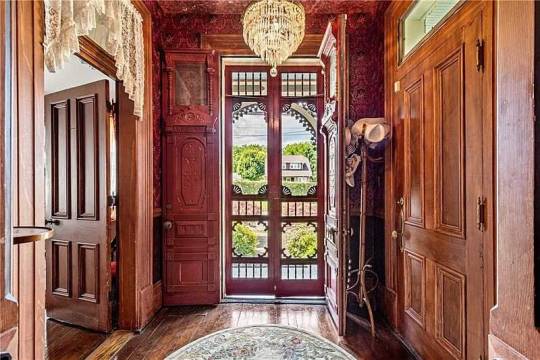





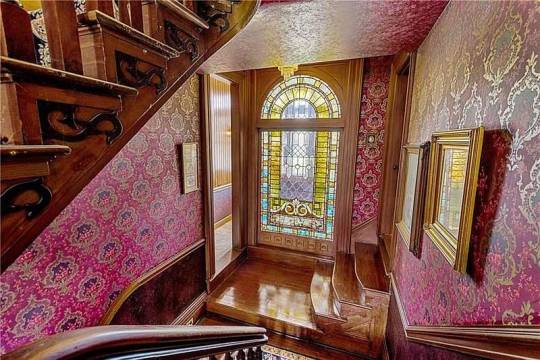

Claysville, PA c.1880
#historic architecture#italianate#Victorian#victorian home#victorian architecture#1880#pennsylvania#old homes#interior design#stunning#red aesthetic#stained glass#staircase#real estate#for sale#homes for sale#victorian era#history#old architecture#architecture
335 notes
·
View notes